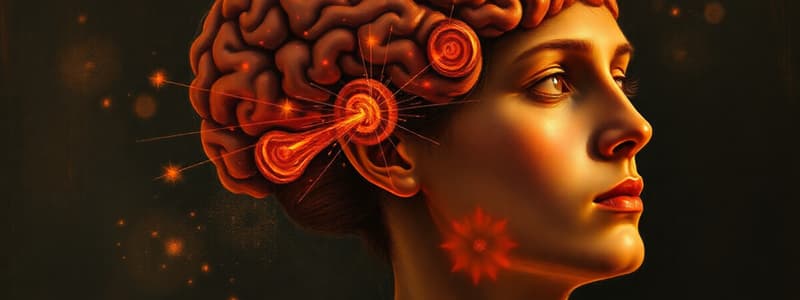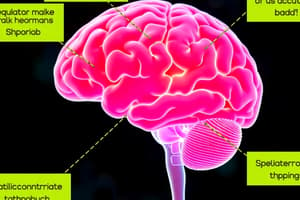Podcast
Questions and Answers
What is the role of IL-1 in the process of fever?
What is the role of IL-1 in the process of fever?
- It increases the production of prostaglandins. (correct)
- It inhibits the action of endogenous pyrogens.
- It directly stimulates shivering.
- It acts on the posterior hypothalamus to lower body temperature.
What physiological mechanism is primarily activated when the body temperature is recognized as lower than the new set-point during a fever?
What physiological mechanism is primarily activated when the body temperature is recognized as lower than the new set-point during a fever?
- Increased sweating.
- Changes in metabolic rate to lower temperature.
- Heat-generating mechanisms like shivering. (correct)
- Vasodilation in peripheral blood vessels.
Which part of the hypothalamus is referred to as the 'feeding center'?
Which part of the hypothalamus is referred to as the 'feeding center'?
- Posterior hypothalamus.
- Medial hypothalamus.
- Anterior hypothalamus.
- Lateral hypothalamus. (correct)
What condition occurs when body temperature increases to a damaging level due to impaired sweating?
What condition occurs when body temperature increases to a damaging level due to impaired sweating?
How do cytokines contribute to the fever response?
How do cytokines contribute to the fever response?
What anatomical structures does the hypothalamus primarily form the walls and floor of?
What anatomical structures does the hypothalamus primarily form the walls and floor of?
Which sensory system does the hypothalamus NOT receive direct sensory inputs from?
Which sensory system does the hypothalamus NOT receive direct sensory inputs from?
Which of the following functions is NOT directly controlled by the hypothalamus?
Which of the following functions is NOT directly controlled by the hypothalamus?
The hypothalamus is part of which larger system in the brain?
The hypothalamus is part of which larger system in the brain?
Which of the following does NOT participate in providing input to the hypothalamus?
Which of the following does NOT participate in providing input to the hypothalamus?
What aspect of homeostasis does the hypothalamus regulate?
What aspect of homeostasis does the hypothalamus regulate?
Which physiological process does the hypothalamus NOT control?
Which physiological process does the hypothalamus NOT control?
How does the hypothalamus integrate temperature-regulating mechanisms?
How does the hypothalamus integrate temperature-regulating mechanisms?
What role does the hypothalamus play in the endocrine system?
What role does the hypothalamus play in the endocrine system?
Which of the following best describes the function of peripheral thermoreceptors?
Which of the following best describes the function of peripheral thermoreceptors?
What occurs when the anterior region of the hypothalamus is lesioned?
What occurs when the anterior region of the hypothalamus is lesioned?
What is the significance of the hypothalamus being sensitive to changes as small as 0.01°C?
What is the significance of the hypothalamus being sensitive to changes as small as 0.01°C?
When the posterior region of the hypothalamus is activated, what reflexes are triggered?
When the posterior region of the hypothalamus is activated, what reflexes are triggered?
How does the hypothalamus receive information about body temperature?
How does the hypothalamus receive information about body temperature?
What role does the Suprachiasmatic nucleus (SCN) play in the body?
What role does the Suprachiasmatic nucleus (SCN) play in the body?
What happens following a large bilateral lesion in the posterior area of the hypothalamus?
What happens following a large bilateral lesion in the posterior area of the hypothalamus?
How does light influence the electrical activity of SCN neurons?
How does light influence the electrical activity of SCN neurons?
What mechanism does the anterior region of the hypothalamus initiate when the body is warm?
What mechanism does the anterior region of the hypothalamus initiate when the body is warm?
What is the primary neurotransmitter linked to wakefulness in the posterior hypothalamus?
What is the primary neurotransmitter linked to wakefulness in the posterior hypothalamus?
What effect do lesions in the anterior area of the hypothalamus have on sleep?
What effect do lesions in the anterior area of the hypothalamus have on sleep?
Which hormone is secreted by the pineal gland to regulate sleep patterns?
Which hormone is secreted by the pineal gland to regulate sleep patterns?
What role does orexin play in the body?
What role does orexin play in the body?
What condition is characterized by excessive daytime sleepiness and inappropriate sleep occurrences?
What condition is characterized by excessive daytime sleepiness and inappropriate sleep occurrences?
Which function is NOT regulated by the Suprachiasmatic nucleus (SCN)?
Which function is NOT regulated by the Suprachiasmatic nucleus (SCN)?
What is the primary function of the ventromedial area?
What is the primary function of the ventromedial area?
Which neurotransmitter from the arcuate nucleus is a potent appetite stimulant?
Which neurotransmitter from the arcuate nucleus is a potent appetite stimulant?
What is the effect of lesions in the ventromedial area?
What is the effect of lesions in the ventromedial area?
Which nucleus secretes hormones that reduce food intake and increase energy metabolism?
Which nucleus secretes hormones that reduce food intake and increase energy metabolism?
What effect does stimulation of the anterior hypothalamus have?
What effect does stimulation of the anterior hypothalamus have?
What triggers drinking behavior in the hypothalamus?
What triggers drinking behavior in the hypothalamus?
Which of the following neurons are sensitive to osmolarity changes and are involved in hormonal regulation of water balance?
Which of the following neurons are sensitive to osmolarity changes and are involved in hormonal regulation of water balance?
Which of the following substances is associated with appetite suppression?
Which of the following substances is associated with appetite suppression?
Flashcards
Hypothalamus Function
Hypothalamus Function
The brain region that integrates many homeostatic functions, receiving input from various sources, controlling endocrine functions, body temperature, food intake, thirst, urine output, sleep-wake cycles, and emotions.
Hypothalamus Location
Hypothalamus Location
Located beneath the thalamus, forming part of the diencephalon and the floor of the third ventricle.
Hypothalamic Nuclei
Hypothalamic Nuclei
The hypothalamus is comprised of various nuclei and nuclear areas, each with specific functions.
Hypothalamus Input
Hypothalamus Input
Signup and view all the flashcards
Hypothalamic Endocrine Control
Hypothalamic Endocrine Control
Signup and view all the flashcards
Hypothalamus and Temperature
Hypothalamus and Temperature
Signup and view all the flashcards
Hypothalamus and Hunger
Hypothalamus and Hunger
Signup and view all the flashcards
Hypothalamus and Sleep-Wake Cycle
Hypothalamus and Sleep-Wake Cycle
Signup and view all the flashcards
Hypothalamic Temperature Regulation
Hypothalamic Temperature Regulation
Signup and view all the flashcards
Hypothalamus and Temperature Sensors
Hypothalamus and Temperature Sensors
Signup and view all the flashcards
Hypothalamus and Set-Point Temperature
Hypothalamus and Set-Point Temperature
Signup and view all the flashcards
Hypothalamus Posterior Region
Hypothalamus Posterior Region
Signup and view all the flashcards
Hypothalamus Anterior Region
Hypothalamus Anterior Region
Signup and view all the flashcards
Hypothalamus Lesion and Heat Regulation
Hypothalamus Lesion and Heat Regulation
Signup and view all the flashcards
Bilateral Posterior Hypothalamic Lesion
Bilateral Posterior Hypothalamic Lesion
Signup and view all the flashcards
Fever: What's happening?
Fever: What's happening?
Signup and view all the flashcards
How is fever triggered?
How is fever triggered?
Signup and view all the flashcards
Heat Stroke: What happens?
Heat Stroke: What happens?
Signup and view all the flashcards
Lateral Hypothalamus Role
Lateral Hypothalamus Role
Signup and view all the flashcards
How does the hypothalamus control feeding?
How does the hypothalamus control feeding?
Signup and view all the flashcards
Ventromedial Area
Ventromedial Area
Signup and view all the flashcards
Glucostatic Theory
Glucostatic Theory
Signup and view all the flashcards
Paraventricular Nucleus
Paraventricular Nucleus
Signup and view all the flashcards
Arcuate Nucleus
Arcuate Nucleus
Signup and view all the flashcards
Neuropeptide Y (NPY)
Neuropeptide Y (NPY)
Signup and view all the flashcards
Melanocortins
Melanocortins
Signup and view all the flashcards
Lateral Hypothalamus
Lateral Hypothalamus
Signup and view all the flashcards
Osmoreceptors
Osmoreceptors
Signup and view all the flashcards
Master Clock
Master Clock
Signup and view all the flashcards
Circadian Rhythm
Circadian Rhythm
Signup and view all the flashcards
Melatonin's Role
Melatonin's Role
Signup and view all the flashcards
SCN and Melatonin
SCN and Melatonin
Signup and view all the flashcards
Anterior Hypothalamus
Anterior Hypothalamus
Signup and view all the flashcards
Posterior Hypothalamus
Posterior Hypothalamus
Signup and view all the flashcards
Histamine's Role
Histamine's Role
Signup and view all the flashcards
Orexin's Role
Orexin's Role
Signup and view all the flashcards




